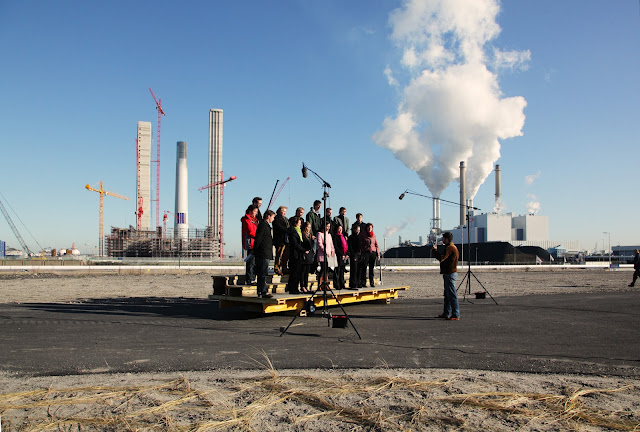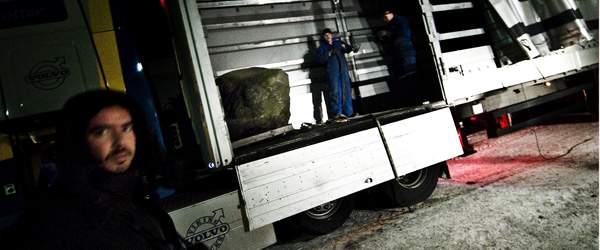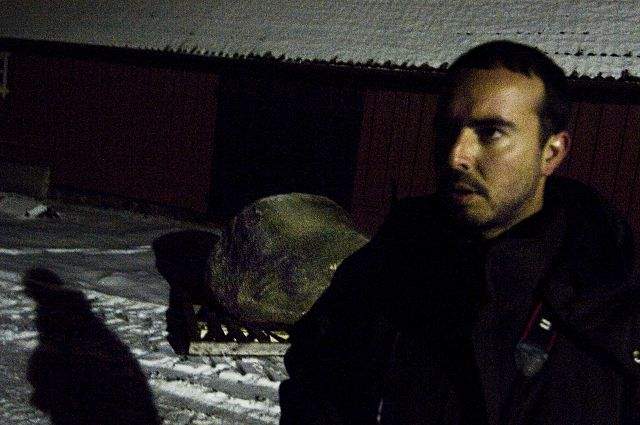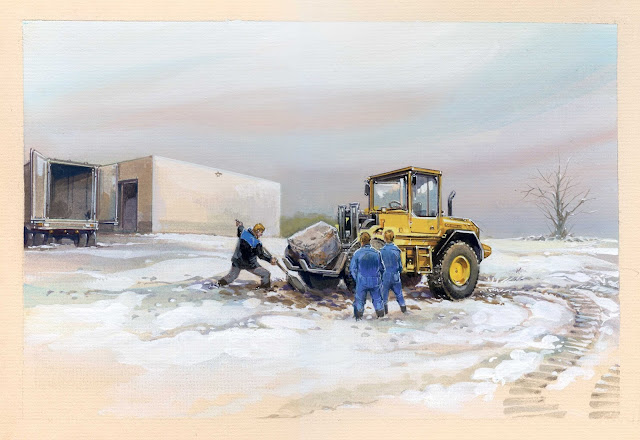Latitudes’ (extended) Environmental Policy Statement
Mon, Apr 17 2023Since its beginning in 2005, Latitudes’ curatorial practice has critically engaged with environmental concerns through contemporary art. This has included curating ambitious group exhibitions including “4.543 billion. The Matter of Matter” at the CAPC musée d’art contemporain de Bordeaux in 2017, and “Greenwashing” at the Fondazione Sandretto Re Rebaudengo in 2008, as well as solo shows such as “Christina Hemauer & Roman Keller: United Alternative Energies” at Kunsthall Århus in 2011, and convening the three-day symposium “Art, Ecology and the Politics of Change” for the Sharjah Biennial 8 in 2007.
In terms of related public-realm commissions, for our first project we selected Danish artist Tue Greenfort to work on The Royal Society of Arts’ pioneering Arts & Ecology programme (2005–2008) and curated ten public art projects around Europe’s largest seaport, the Port of Rotterdam (“Portscapes” in 2009–2010). We have also organised curatorial residencies around geological agency (“Geologic Time”, Banff Centre, 2017) and a touring film programme on the legacy of Land Art (“A Stake in the Mud a Hole in the Reel”, 2008–2009) in contemporary art.
Last but not least, since 2008 we have been custodians of the RAF/Reduce Art Flights website, a reference resource about the campaign initiated by the late Gustav Metzger (1926–2017).
Latitudes' environmental impact is small, yet we recognize that air travel and the broader mobility patterns within our industry contribute the most to our ecological footprint. Art and culture have a role to play in bringing about ambitious change, applying best practices and setting a positive example to position the climate crisis at the centre of the political and social debate.
In January 2023 we became individual members of the Gallery Climate Coalition (GCC) and began to work with colleagues to set up the Spanish volunteer team, GCC Spain, that meets regularly to track progress on environmental targets and actions.
Latitudes requests external collaborators opt for train or alternative low-carbon transit and freight options in line with GCC’s guidelines (as well as Gustav Metzger’s RAF/Reduce Art Flights campaign) and this is reflected in work contracts. We hope to lead by example in implementing a sustainability strategy in the planning of exhibitions from an early stage, and whenever curating projects we always try to build the minimum necessary temporary architecture and ensure that any exhibition-related production is entirely locally tuned. We ask that collaborators use no plastic or other single-use materials when transporting works or for events.
Latitudes’ website runs on sustainable energy. According to websitecarbon.com (see stats below), LTTDS.org produces 16.76kg of C02 equivalent per year, roughly the amount of carbon that one tree would absorb in the same time, and it consumes 44kWh of energy (equivalent to 280km in an electric car).
In our personal lives, we prioritise the 5 Rs: Refusing, Reducing, Reusing, Repurposing and Recycling. We do not own a car and use public transport networks. Other practical actions we undertake include periodically donating household or clothing items to charity organisations that offer support to vulnerable communities in our neighbourhood (including Fundació Roure and El Trampolí). Last but not least, since 2013, Latitudes has banked with an ethical bank that finances initiatives contributing to ecological, social, and cultural change.
- Gallery Climate Coalition (GCC) en el Estado español, 25 January 2023
- Latitudes’ essay “Un suelo para las historias del arte del futuro” [Soil for Future Art Histories] in TBA21’s catalogue “Futuros Abundantes / Abundant Futures”, 22 Jan 2023
- “‘Minor’ Ornithologies” podcast conducted by Max Andrews of Latitudes for TBA21 on st_age, 27 Sep 2022
- Cover Story, September 2021: Erratic behaviour—Latitudes in conversation with Jorge Satorre, 31 Aug 2021
- 18 marzo 2021, 18:30h: Mesa redonda “Transformación geológica y construcción artificial” con Lara Almarcegui y Juan Guardiola, 8 Mar 2021
- Lead Faculty, Geologic Time, Banff International Curatorial Institute, Visual + Digital Arts Department, Banff Centre for Arts and Creativity, Banff, Canada, 11 September–6 October 2017
- Group exhibition, “4.543 billion. The matter of matter”, CAPC musée d’art contemporain Bordeaux, France, 29 June 2017–7 January 2018
- Editors, “Lara Almarcegui. Projects 1995–2010”, Archive Books, 2011
- Solo exhibition, “Christina Hemauer & Roman Keller: United Alternative Energies”, Kunsthal Aarhus, Århus, Denmark, 22 January–3 April 2011
- Public realm commissions, Portscapes, Port of Rotterdam, the Netherlands, throughout 2009
- Custodians, Reduce Art Flights (RAF) website (2008–ongoing)
- Touring film programme, “A Stake in the Mud, A Hole in the Reel. Land Art’s Expanded Field 1968–2008”, Museo Tamayo, Mexico City, and other venues, April–October 2008
- Group exhibition “Greenwashing. Perils, Promises and Perplexities”, Fondazione Sandretto Re Rebaudengo, Torino, February–May 2008
- Convenors, “Art, Ecology and the Politics of Change”, 3-day symposium during the Sharjah Biennial 8, 5–7 April 2007
- Editors, “UOVO #14: Ecology, Luxury and Degradation”, 2007
- Editor, “LAND, ART: A Cultural Ecology Handbook” (2006)
- Curator, Tue Greenfort, Arts & Ecology public realm commission in London, 2005–2008
Cover Story – December 2016: Ten years ago – Land, Art: A Cultural Ecology Handbook
Mon, Dec 5 2016Related content:
- Archive of Cover Stories
- Photos of the launch of the publication 'LAND, ART: A Cultural Ecology Handbook' at the LCE, London 15 December 2006
- Photos of the publication 'LAND, ART: A Cultural Ecology Handbook' (RSA, 2006) 14 December 2006
- Looking back – Visiting Robert Smithson's 'Spiral Jetty' (1970) 7 September 2004
- Cover Story, November 2016: Plucking Gilda, synesthetic Toni and dazzling Víctor 2 November 2016
- Cover Story, October 2016: "A Funny thing Happened on the Way to the Gallery, 13 October 2016
- Cover Story, September 2016: "El misterio de Caviria" by Antoni Hervàs 1 Septiembre 2016
- Last chance to read the August 2016 Monthly Cover Story "Fermínlandia" 31 August 2016
Portscapes: Jorge Satorre returns an ice-age boulder back to Sweden
Mon, Jan 18 2010Jorge Satorre's project for Portscapes had its beginnings in the eastern part of the Netherlands with a 3-tonne gneissic granite rock from the Svecofennian age, approximately 1.9 billion years ago. Following the artist’s fascination with the environmental compensation practices being instigated alongside the construction of Maasvlakte 2, his project consisted of returning the rock to where it once came from in Sweden – an act of synthetic restitution and transnational sculptural offsetting.
The boulder has now found a permanent home at the Wanås Foundation, near Knislinge in southern Sweden [1]. The boulder was transported from Erica, in the northeast of The Netherlands, to Knislinge at the beginning of January (see report on the Swedish newspaper Kristianstadsbladet).
Not insignificantly, the celebrated Land art work 'Broken Circle' (1971) by Robert Smithson, sited in a working quarry near Emmen, incorporates such a seemingly immovable boulder at its centre. Satorre’s reverse geological gesture is also reflected in the fact that much of the existing and future sea defence in the port area will be made from rock brought from Scandinavia. The artist offers an account of the process through drawings, which incorporates both actual and imagined details. One such detail depicts an imagined protest at the beginning of the boulder’s homeward journey – see post 2 October 2009.
Jorge Satorre's project was produced in the context of 'Portscapes', an accumulative series of newly commissioned projects produced in the context of the 2,000-hectare extension to the Port of Rotterdam, the project Maasvlakte 2.
An exhibition with 'Portscapes' projects will be on view at the Museum Boijmans van Beuningen, Rotterdam between 30 January and 25 April 2010 (Reception: Friday 5 February, 20h).
Portscapes was commissioned by the Port of Rotterdam Authority with advice and support from SKOR (Foundation Art and Public Space, Amsterdam) and was curated by Latitudes.
[FOOTNOTE 1] The foundation estate encompasses a medieval castle, an organic farm, and a sculpture park which since 1987 has hosted a number of permanent works by international artists.
Images: Journey and placement of the boulder from the newspaper Kristianstadsbladet; Drawings of 'The Erratic. Measuring Compensation' (2009), courtesy of the artist.
Portscapes news: Jorge Satorre's billboard on the A15 and Paulien Oltheten small exhibition at the visitor centre Futureland and surroundings
Fri, Oct 2 2009Placed along the A15 highway on the Maasvlakte, Jorge Satorre's billboard is the third installed as part of 'Portscapes' – joining those by Hans Schabus and Paulien Oltheten.
During the summer of 2009, Jorge Satorre was searching for, and eventually located, a large boulder – specifically one of the giant rocks carried by glaciers into The Netherlands from Scandinavia during the last Ice Age. Following the artist’s fascination with the environmental compensation projects being instigated alongside the construction of Maasvlakte 2, his project seeks to identify this rock’s precise place of origin and then return it to where it came from – an act of synthetic restitution and transnational sculptural offsetting. Satorre’s reverse geological gesture furthermore mirrors the monumental construction of the Maasvlakte 2 as a sculpting of land-form which, like the action of ice but in a far shorter time, is fundamentally altering the morphology of The Netherlands. The action is also reflected in the fact that much of the existing and future sea defense in the port area will be made from rock brought from Scandinavia. The artist’s accompanying pencil drawings offer an account of the process which incorporate both actual and imagined details, like a storyboard. A single drawing which depicts an imagined protest at the beginning of the boulder’s journey is realised as a billboard near the Futureland visitor’s centre.
A second part of his research will be presented at the Portscapes exhibition at the Museum Boijmans van Beuningen from 5 February 2010.
Paulien Oltheten's videos and photographs can also be seen until mid-November 2009 in and around Futureland, the Maasvlakte visitors’ centre [MAP HERE]. From there, visitors can set off with a route description to the locations on the Maasvlakte where other work can be seen.
Locations and some images of Oltheten's mini-billboards:
The public domain and human behaviour is the starting point for the work of Paulien Oltheten (1982), though she has described her approach as closer to that of an anthropologist rather than artist. With her still and video cameras, she generally searches with apparent casualness for moments when there is contact between people, objects and public space. On the Maasvlakte, Oltheten was faced with the fact that the familiar frame of reference of natural elements, such as trees, bushes and people, was almost completely lacking. Oltheten decided to make use of this alienation by arranging meetings with people. This resulted in a series of photographs and two short video pieces. These stagings mostly take place in locations on the Maasvlakte that will disappear or be displaced during the coming years. The photographs and videos are sometimes variations on the theme of ‘one becomes two’, referring to the Maasvlakte, of which there will later be two.
Futureland is on Europaweg 909, 3199 LC Maasvlakte, Rotterdam (Havennummer 8213). It is across the road from the E.ON power plant. Open Tuesday-Friday 10am-5pm and on Sunday 11am-5pm. Entry is free. Map here.

Portscapes is a series of public art commissions initiated by the Port of Rotterdam Authority with advice and support from SKOR (Foundation for Art and Public Space, Amterdam) and curated by Latitudes. www.portscapes.nl
[Photos of Jorge Satorre's board by Ben Wind; Photos of Paulien Oltheten's by the artist and Ben Wind.]

























